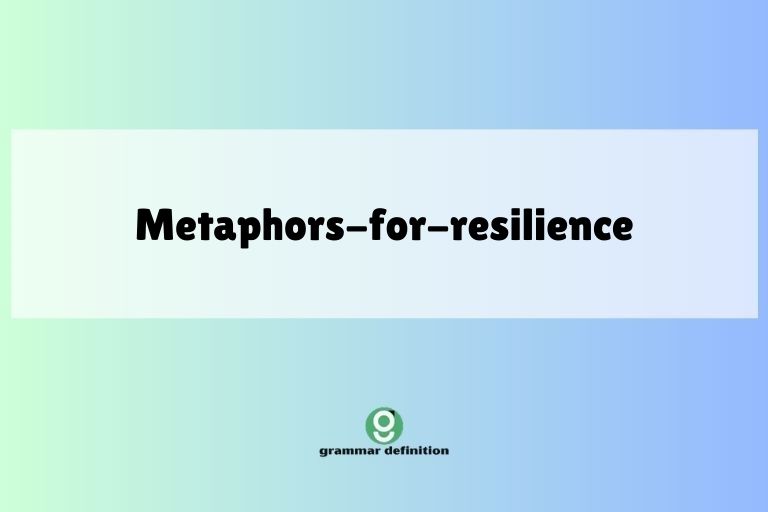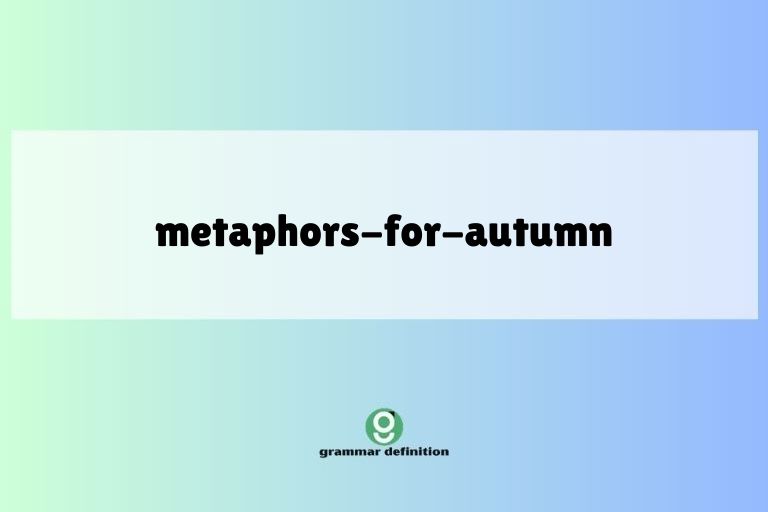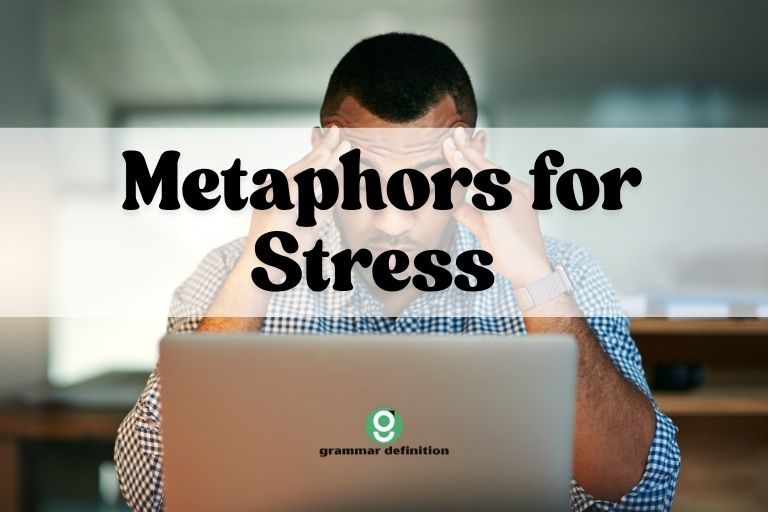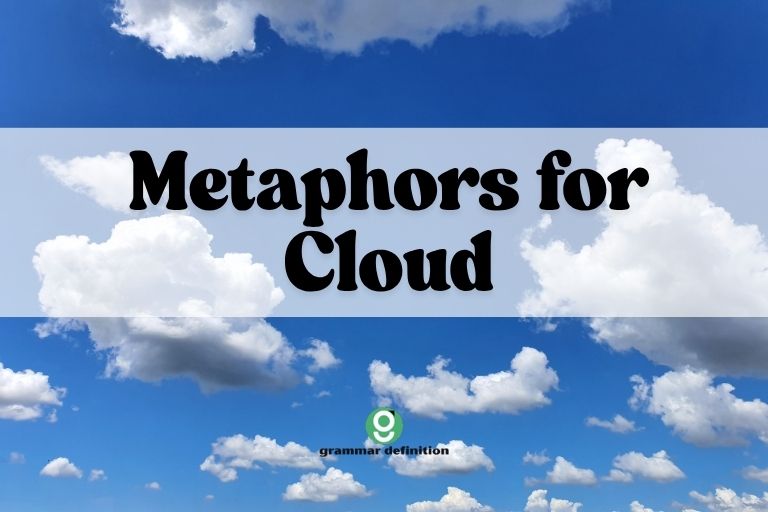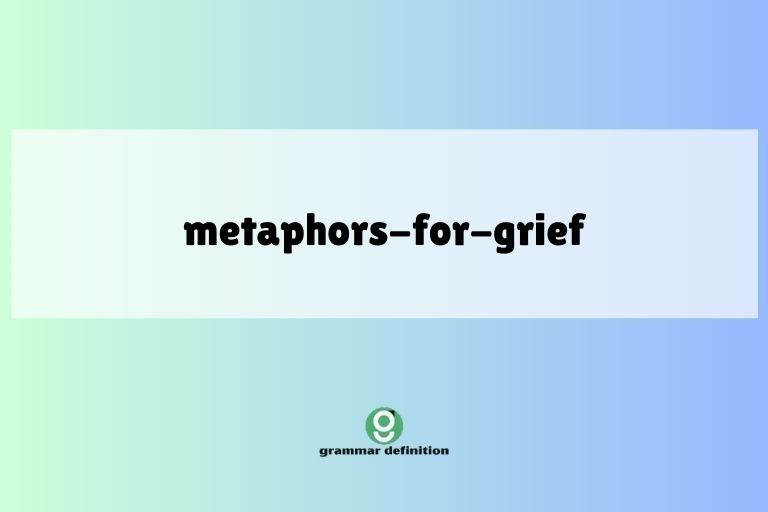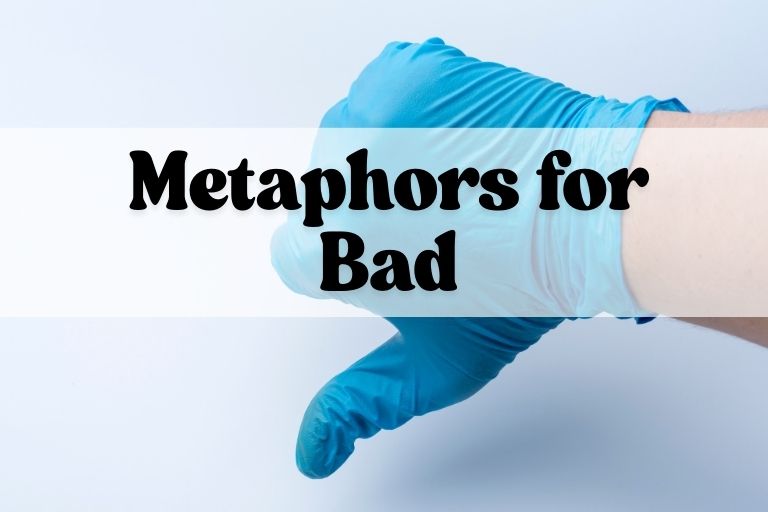Painting Pictures with Words: Metaphors in Art
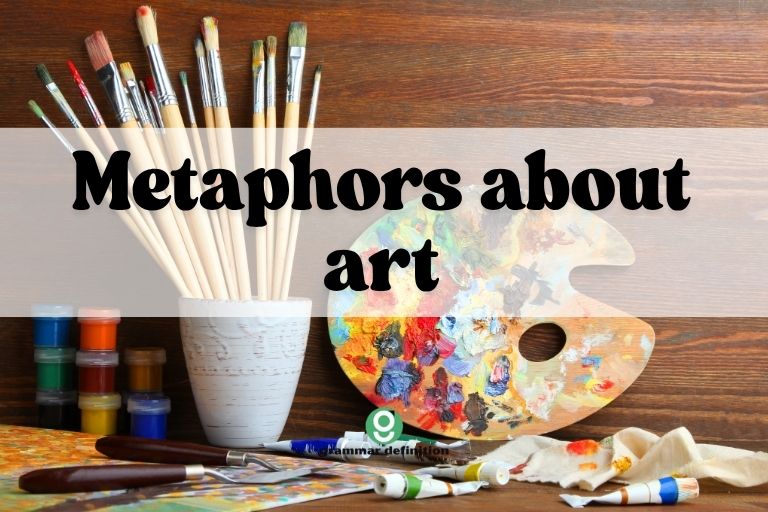
Metaphors are powerful tools that allow us to understand abstract and complex concepts by relating them to something familiar. In the realm of art, metaphors are particularly potent, offering a way to express the inexpressible, evoke emotions, and deepen our understanding of artistic creations.
Mastering the use and interpretation of metaphors about art can significantly enhance your communication skills and appreciation of artistic expression. This article will guide you through the intricacies of metaphors in art, providing definitions, examples, usage rules, and practice exercises to help you master this essential aspect of English grammar and literary analysis.
This guide is useful for students, art enthusiasts, writers, and anyone looking to improve their understanding and use of figurative language.
Through this comprehensive guide, you’ll learn to identify and analyze different types of metaphors used to describe and interpret art. By understanding the nuances of these metaphors, you’ll be able to articulate your thoughts about art more effectively and engage in more meaningful discussions about artistic expression.
Table of Contents
- Introduction
- Definition of Metaphor in Art
- Structural Breakdown of Art Metaphors
- Types of Art Metaphors
- Examples of Metaphors About Art
- Usage Rules for Art Metaphors
- Common Mistakes with Art Metaphors
- Practice Exercises
- Advanced Topics in Art Metaphors
- Frequently Asked Questions
- Conclusion
Definition of Metaphor in Art
A metaphor is a figure of speech that directly compares two unrelated things without using “like” or “as.” It asserts that one thing *is* another, attributing qualities of the second thing to the first. In the context of art, metaphors are used to describe, interpret, and understand various aspects of artistic creations, from paintings and sculptures to music and literature.
They help us see art in new and insightful ways by drawing parallels between the artwork and something else that is more easily understood or emotionally resonant.
Metaphors in art serve several key functions. They can simplify complex ideas, evoke emotions, provide new perspectives, and enhance the aesthetic experience.
For example, saying a painting is “a symphony of colors” suggests that the colors work together harmoniously, much like the instruments in an orchestra. This metaphor not only describes the visual aspect of the painting but also evokes a sense of harmony and beauty.
Understanding metaphors is crucial for appreciating the deeper meanings and intentions behind artistic works. It allows us to move beyond a literal interpretation and engage with the artwork on a more emotional and intellectual level.
Without recognizing and understanding the metaphors used in art criticism and analysis, we may miss the subtle nuances and profound insights that the artist or critic is trying to convey.
Structural Breakdown of Art Metaphors
The structure of a metaphor involves two main components: the tenor and the vehicle. The tenor is the subject being described (in this case, the artwork or its aspect), and the vehicle is the object or concept to which it is being compared. The vehicle lends its qualities to the tenor, creating a new understanding of the subject.
Consider the metaphor “This sculpture is a frozen dance.” Here, “sculpture” is the tenor, and “frozen dance” is the vehicle. The vehicle suggests that the sculpture possesses qualities of movement, grace, and rhythm, even though it is a static object.
The effectiveness of a metaphor depends on the connection between the tenor and the vehicle. The more resonant and insightful the connection, the more powerful the metaphor.
Metaphors can be explicit or implicit. An explicit metaphor directly states the comparison, while an implicit metaphor suggests the comparison without explicitly stating it.
For example, “The painting’s vibrant colors shouted for attention” is an explicit metaphor. An implicit metaphor might be: “The canvas pulsed with energy,” where the vibrancy is implied without a direct comparison.
Another important aspect of the structure is the ground, which refers to the shared characteristics between the tenor and the vehicle that make the metaphor meaningful. In the “frozen dance” example, the ground might be the sense of movement and rhythm that both dance and sculpture can evoke. Identifying the ground is crucial for understanding the intended meaning of the metaphor.
Types of Art Metaphors
Art metaphors can be categorized based on the type of connection they establish between the artwork and the concept used for comparison. Here are some common types of art metaphors:
Visual Metaphors
Visual metaphors relate the visual elements of the artwork to other visual experiences or concepts. These metaphors often focus on color, shape, texture, and composition.
For example, “The painting is a window into another world” uses the image of a window to convey the idea that the painting offers a glimpse into a different reality. Similarly, “The sculpture’s smooth surface is a mirror reflecting the viewer’s emotions” connects the tactile quality of the sculpture with the viewer’s emotional state.
Emotional Metaphors
Emotional metaphors connect the artwork’s impact on the viewer to specific emotions or emotional experiences. They describe the feelings evoked by the artwork.
Examples include “The music is a balm for the soul,” which suggests that the music provides comfort and healing. Another example is “The poem is a lament for lost love,” which indicates that the poem expresses sorrow and grief over a past relationship.
Temporal Metaphors
Temporal metaphors relate the artwork to time, either in terms of its creation, its historical context, or its impact on the viewer over time.
For example, “The novel is a time capsule of the Victorian era” suggests that the novel preserves and conveys the essence of that historical period. Another example is “The performance is a fleeting moment of beauty,” which emphasizes the ephemeral nature of live performance.
Metaphors of Creation
These metaphors describe the process of creating art, often focusing on the artist’s role, the materials used, and the challenges overcome.
For example, “The artist sculpted his vision from raw emotion” conveys the idea that the artist transformed intense feelings into a tangible artwork. Another example is “The composer built his symphony brick by brick,” which suggests that the composition was a deliberate and painstaking process.
Metaphors of Interpretation
These metaphors describe how we understand and interpret art, often focusing on the viewer’s or critic’s role in making meaning.
For example, “The critic dissected the film with surgical precision” suggests that the critic analyzed the film meticulously and incisively. Another example is “The audience embraced the play as a reflection of their own lives,” which indicates that the audience found personal meaning and relevance in the performance.
Examples of Metaphors About Art
Here are several examples of metaphors about art, categorized for clarity. Each category includes a variety of examples to illustrate the diverse ways in which metaphors can be used to describe and interpret art.
The following tables provide a comprehensive look at metaphors used to describe art, categorized by their focus. Each table includes specific examples of metaphors and their interpretations, helping you understand how these figures of speech enhance our understanding and appreciation of art.
Table 1: Visual Metaphors
This table highlights metaphors that describe the visual aspects of art, such as color, composition, and texture. These metaphors help to create vivid images in the reader’s mind and convey the artistic intent behind the visual elements.
| Metaphor | Interpretation |
|---|---|
| The painting is a symphony of colors. | The colors work together harmoniously, creating a beautiful and balanced composition. |
| The sculpture’s lines are a dance of elegance. | The lines of the sculpture create a sense of graceful movement and sophistication. |
| The mosaic is a garden of tiny stones. | The mosaic is composed of many small, colorful pieces that resemble a vibrant garden. |
| The photograph is a mirror reflecting reality. | The photograph captures a realistic image of the world, reflecting its true nature. |
| The mural is a window into history. | The mural depicts historical events, offering a glimpse into the past. |
| The artwork is a tapestry of emotions. | The artwork weaves together various emotions, creating a complex and rich experience. |
| The canvas is a battlefield of light and shadow. | The artist uses light and shadow to create dramatic contrast and tension in the painting. |
| The design is a blueprint for the future. | The design represents a plan or vision for what is to come. |
| The sculpture’s texture is a landscape of rough terrain. | The texture of the sculpture is uneven and rugged, resembling a natural landscape. |
| The painting’s brushstrokes are whispers of the artist’s hand. | The brushstrokes reveal the artist’s personal touch and technique. |
| The stained glass is a kaleidoscope of colors. | The stained glass creates a dazzling array of colors and patterns. |
| The architecture is a poem in stone. | The architecture is beautiful and expressive, like a work of poetry. |
| The sketch is a roadmap of the artist’s thoughts. | The sketch provides a visual guide to the artist’s creative process. |
| The abstract art is a puzzle of shapes and forms. | The abstract art challenges the viewer to interpret the meaning behind the shapes and forms. |
| The digital art is a world of pixels and code. | The digital art is created using digital technology, composed of pixels and code. |
| The collage is a scrapbook of memories. | The collage combines various elements to evoke memories and experiences. |
| The installation is a playground for the senses. | The installation engages multiple senses, creating an immersive experience. |
| The print is a stamp of the artist’s identity. | The print bears the unique mark and style of the artist. |
| The animation is a dream brought to life. | The animation transforms imaginative ideas into a moving visual narrative. |
| The graffiti is a voice of the streets. | The graffiti expresses the thoughts and feelings of the urban community. |
| The artwork is a stage for human drama. | The artwork depicts scenes of human life, with all its conflicts and emotions. |
| The painting is a silent scream. | The painting expresses intense emotion without the use of sound. |
| The canvas is a blank page inviting stories. | The canvas offers the opportunity for the artist to create new narratives. |
| The sculpture is a monument to human achievement. | The sculpture celebrates human accomplishments and ideals. |
Table 2: Emotional Metaphors
Emotional metaphors delve into the feelings and emotions that art evokes. These metaphors often use emotive language to describe the artwork’s impact on the audience, creating a deeper connection between the art and its viewers.
| Metaphor | Interpretation |
|---|---|
| The music is a balm for the soul. | The music provides comfort, healing, and relaxation. |
| The poem is a lament for lost love. | The poem expresses sorrow and grief over a past relationship. |
| The play is a mirror reflecting our fears. | The play reflects the audience’s anxieties and insecurities. |
| The novel is a journey through the human heart. | The novel explores the complexities of human emotions and relationships. |
| The dance is an expression of pure joy. | The dance conveys a sense of happiness and elation. |
| The film is a window into human suffering. | The film portrays the pain and hardships experienced by people. |
| The opera is a tempest of passion. | The opera is full of intense emotions and dramatic events. |
| The song is a cry for freedom. | The song expresses a strong desire for liberation and independence. |
| The symphony is a celebration of life. | The symphony is a joyful and uplifting tribute to existence. |
| The ballad is a whisper of hope. | The ballad offers a subtle but persistent sense of optimism. |
| The artwork is a beacon of light in dark times. | The artwork provides guidance and inspiration during difficult periods. |
| The performance is a release of pent-up emotions. | The performance allows the performers and audience to express repressed feelings. |
| The painting is a silent scream of anguish. | The painting expresses intense pain and suffering without the use of sound. |
| The sculpture is a frozen tear of sorrow. | The sculpture embodies the feeling of sadness and grief. |
| The photograph is a snapshot of fleeting happiness. | The photograph captures a brief moment of joy and contentment. |
| The film score is a heartbeat of suspense. | The music in the film creates a sense of tension and anticipation. |
| The poem is an echo of past sorrows. | The poem reflects on past experiences of grief and loss. |
| The dance is a conversation of unspoken feelings. | The dance communicates emotions through movement and expression. |
| The song is a lullaby for the weary soul. | The song provides comfort and rest for those who are tired and stressed. |
| The artwork is a tapestry of shared human experience. | The artwork weaves together common emotions and events that connect people. |
| The play is a battlefield of conflicting desires. | The play presents characters struggling with their inner and outer conflicts. |
| The novel is a voyage into the depths of the human psyche. | The novel explores the complexities of the human mind and emotions. |
| The symphony is a crescendo of triumph over adversity. | The symphony builds to a powerful and victorious climax. |
Table 3: Temporal Metaphors
Temporal metaphors connect art to time, whether it’s the historical context, the duration of its creation, or its lasting impact. These metaphors help to place the art within a broader timeline and highlight its significance over time.
| Metaphor | Interpretation |
|---|---|
| The novel is a time capsule of the Victorian era. | The novel preserves and conveys the essence of that historical period. |
| The performance is a fleeting moment of beauty. | The performance is ephemeral and exists only for a short time. |
| The painting is a snapshot of a bygone era. | The painting captures a moment from the past, preserving it for future generations. |
| The sculpture is a monument to ancient civilizations. | The sculpture commemorates the achievements and culture of ancient societies. |
| The film is a mirror reflecting the present day. | The film reflects the current social and cultural issues of the time. |
| The song is an echo of past generations. | The song carries the voices and experiences of previous generations. |
| The play is a timeless tale of human nature. | The play explores universal aspects of human behavior that remain relevant across time. |
| The artwork is a bridge connecting the past and the future. | The artwork links historical traditions with contemporary ideas. |
| The dance is a ritual passed down through centuries. | The dance has been performed for generations, preserving cultural traditions. |
| The poem is a message in a bottle from another age. | The poem conveys thoughts and feelings from a different time period. |
| The architecture is a testament to enduring human creativity. | The architecture demonstrates the lasting power of human imagination and skill. |
| The photograph is a frozen moment in the river of time. | The photograph captures a single instant from the continuous flow of time. |
| The film is a chronicle of social change. | The film documents and reflects the evolution of society. |
| The song is a soundtrack to a generation’s memories. | The song evokes nostalgia and reminds people of a particular time in their lives. |
| The play is a mirror reflecting the anxieties of our age. | The play highlights the current concerns and fears of contemporary society. |
| The artwork is a legacy that transcends time. | The artwork has a lasting impact and remains relevant for future generations. |
| The dance is a living history expressed through movement. | The dance embodies cultural traditions and historical narratives. |
| The poem is a timeless voice speaking to the human condition. | The poem addresses universal themes and emotions that resonate across time. |
| The novel is a journey through the corridors of history. | The novel explores historical events and their impact on characters and society. |
| The symphony is an eternal melody echoing through the ages. | The symphony has a timeless quality and continues to inspire listeners. |
| The art installation is a temporary portal to another reality. | The art installation creates an immersive experience that transports viewers to a different world. |
| The digital art is a snapshot of the digital age. | The digital art captures the essence of contemporary technology and culture. |
| The graffiti is an ephemeral mark on the urban landscape. | The graffiti is temporary and subject to change, reflecting the dynamic nature of the city. |
Usage Rules for Art Metaphors
Using metaphors effectively requires understanding certain rules and guidelines. Here are some key principles to follow:
- Clarity: The metaphor should be clear and easily understood. Avoid obscure or overly complex comparisons that might confuse the audience.
- Relevance: The connection between the tenor and the vehicle should be relevant and meaningful. The shared characteristics should be evident and significant.
- Originality: Strive for originality in your metaphors. Avoid clichés and overused comparisons that have lost their impact.
- Consistency: Maintain consistency in your metaphorical language. Avoid mixing metaphors that create conflicting or nonsensical images.
- Context: Consider the context in which the metaphor is used. The appropriateness of a metaphor may depend on the audience, the subject matter, and the overall tone of the communication.
For example, instead of saying “The painting is like a dream,” which is a cliché, try “The painting is a dreamscape of swirling colors and ethereal forms.” This metaphor is more specific and evocative, creating a stronger image in the reader’s mind.
Common Mistakes with Art Metaphors
Here are some common mistakes to avoid when using metaphors about art:
- Mixed Metaphors: Combining two or more inconsistent metaphors.
- Incorrect: “The play was a rollercoaster of emotions that sailed through the audience.” (Mixing “rollercoaster” and “sailed”)
- Correct: “The play was a rollercoaster of emotions.” or “The play sailed through the audience, captivating everyone.”
- Clichés: Using overused and unoriginal metaphors.
- Incorrect: “The music was like a breath of fresh air.”
- Correct: “The music was a refreshing breeze on a stifling day.”
- Obscurity: Using metaphors that are too abstract or difficult to understand.
- Incorrect: “The sculpture was a quantum entanglement of form and space.”
- Correct: “The sculpture was an intricate interplay of form and space, creating a sense of interconnectedness.”
- Inappropriateness: Using metaphors that are not suitable for the context or audience.
- Incorrect: “The somber painting was a party in a frame.”
- Correct: “The somber painting was a shroud of darkness, reflecting the artist’s grief.”
Avoiding these mistakes will help you use metaphors more effectively and create more impactful and meaningful descriptions of art.
Practice Exercises
Test your understanding of metaphors about art with these exercises. Identify the metaphor in each sentence and explain its meaning.
Exercise 1: Identifying Metaphors
Identify the metaphor in each sentence and explain its meaning.
| Question | Answer |
|---|---|
| 1. The film was a tapestry of interwoven stories. | Metaphor: “tapestry of interwoven stories.” Meaning: The film combined multiple narratives into a complex and coherent whole. |
| 2. The sculpture was a silent scream of defiance. | Metaphor: “silent scream of defiance.” Meaning: The sculpture expressed strong resistance and protest without the use of sound. |
| 3. The poem was a key unlocking hidden emotions. | Metaphor: “key unlocking hidden emotions.” Meaning: The poem revealed and released suppressed feelings. |
| 4. The painting was a battlefield of clashing colors. | Metaphor: “battlefield of clashing colors.” Meaning: The painting used contrasting colors to create tension and conflict. |
| 5. The music was a river flowing through the audience. | Metaphor: “river flowing through the audience.” Meaning: The music moved and affected the audience in a powerful and continuous way. |
| 6. The play was a mirror reflecting society’s flaws. | Metaphor: “mirror reflecting society’s flaws.” Meaning: The play depicted and exposed the imperfections and problems of society. |
| 7. The dance was a conversation between bodies. | Metaphor: “conversation between bodies.” Meaning: The dance communicated emotions and ideas through movement and expression. |
| 8. The novel was a labyrinth of intricate plots. | Metaphor: “labyrinth of intricate plots.” Meaning: The novel had a complex and confusing storyline with many twists and turns. |
| 9. The artwork was a lighthouse guiding lost souls. | Metaphor: “lighthouse guiding lost souls.” Meaning: The artwork provided hope and direction to those who were struggling or confused. |
| 10. The song was a bandage on a wounded heart. | Metaphor: “bandage on a wounded heart.” Meaning: The song provided comfort and healing to someone who was emotionally hurt. |
Exercise 2: Creating Metaphors
Create your own metaphor to describe each artwork.
| Artwork | Your Metaphor |
|---|---|
| A vibrant abstract painting | Answer: A kaleidoscope of emotions splashed across a boundless universe. |
| A somber classical sculpture | Answer: A frozen storm of grief etched in stone. |
| An energetic pop song | Answer: A shot of adrenaline straight to the heart. |
| A thought-provoking documentary film | Answer: A scalpel dissecting the layers of truth. |
| A minimalist architectural design | Answer: A haiku in steel and glass. |
| An intricate and colorful mosaic | Answer: A garden of dreams blooming in tesserae. |
| A powerful and moving theatrical performance | Answer: A lightning strike igniting the soul. |
| A haunting and melancholic poem | Answer: A whisper of sorrow echoing through the ages. |
| A bold and provocative graffiti mural | Answer: A roar of rebellion painted on the city’s skin. |
| A serene and calming landscape photograph | Answer: A sanctuary of peace captured in a frame. |
Exercise 3: Correcting Mixed Metaphors
Identify and correct the mixed metaphors in the following sentences.
| Question | Corrected Sentence |
|---|---|
| 1. The film was a rollercoaster of emotions that painted a vivid picture. | Corrected: The film was a rollercoaster of emotions. OR The film painted a vivid picture. |
| 2. The song was a beacon of hope that sailed through the night. | Corrected: The song was a beacon of hope. OR The song sailed through the night, filling it with melody. |
| 3. The play was a mirror reflecting our fears that blossomed into a beautiful garden. | Corrected: The play was a mirror reflecting our fears. OR The play blossomed into a beautiful garden of understanding. |
| 4. The novel was a journey through the human heart that was also a symphony of words. | Corrected: The novel was a journey through the human heart. OR The novel was a symphony of words. |
| 5. The artwork was a bridge connecting the past and the future that also danced on the canvas. | Corrected: The artwork was a bridge connecting the past and the future. OR The artwork danced on the canvas, full of life and energy. |
| 6. The sculpture was a frozen moment in time that also whispered secrets to the wind. | Corrected: The sculpture was a frozen moment in time. OR The sculpture whispered secrets to the wind. |
| 7. The dance was an expression of pure joy that also dissected the human condition. | Corrected: The dance was an expression of pure joy. OR The dance dissected the human condition. |
| 8. The poem was a lament for lost love that also illuminated the path forward. | Corrected: The poem was a lament for lost love. OR The poem illuminated the path forward. |
| 9. The painting was a silent scream of anguish that also echoed through the halls of time. | Corrected: The painting was a silent scream of anguish. OR The painting echoed through the halls of time. |
| 10. The music was a balm for the soul that also painted a thousand pictures. | Corrected: The music was a balm for the soul. OR The music painted a thousand pictures in the listener’s mind. |
Advanced Topics in Art Metaphors
For advanced learners, exploring the theoretical underpinnings of metaphor can provide a deeper understanding of their function and impact. Consider researching the following:
- Conceptual Metaphor Theory: This theory, developed by George Lakoff and Mark Johnson, argues that metaphors are not just linguistic devices but also fundamental cognitive structures that shape our understanding of the world.
- Metaphorical Analysis: This involves systematically identifying and analyzing the metaphors used in a particular text or discourse to reveal underlying assumptions and ideologies.
- The Role of Metaphor in Art Criticism: Explore how art critics use metaphors to interpret and evaluate artworks, and how these metaphors shape our understanding of art history and aesthetics.
Further study of these topics will enhance your ability to critically analyze and appreciate the use of metaphors in art and literature.
Frequently Asked Questions
- What is the difference between a metaphor and a simile?A metaphor directly equates two things, stating that one *is* the other. A simile, on the other hand, uses “like” or “as” to make a comparison, suggesting that one thing is *similar* to another. For example, “The painting is a symphony of colors” is a metaphor, while “The painting is like a symphony” is a simile. Similes are generally considered less forceful than metaphors because they acknowledge a degree of difference between the two things being compared, whereas metaphors assert a complete identification.
- Why are metaphors important in art criticism?Metaphors are crucial in art criticism because they provide a way to describe and interpret complex and abstract qualities of artworks. They allow critics to convey their subjective experiences and insights in a vivid and engaging manner, helping readers to understand and appreciate the artwork on a deeper level. Metaphors can also reveal underlying themes, cultural contexts, and artistic intentions that might not be immediately apparent.
- How can I improve my ability to identify metaphors in art?Improving your ability to identify metaphors in art involves developing a sensitivity to figurative language and a willingness to look beyond the literal meaning of words. Pay attention to comparisons that are not explicitly stated and consider the qualities that the artwork and the compared concept share. Practice analyzing different types of art and reading art criticism to familiarize yourself with common metaphorical expressions. The more you expose yourself to metaphorical language, the better you will become at recognizing it.
- What are some common metaphors used to describe music?Common metaphors used to describe music often relate to emotions, colors, and physical sensations. For example, music might be described as “a wave of emotion,” “a tapestry of sounds,” “a balm for the soul,” or “a journey through different landscapes.” These metaphors help to convey the emotional impact, complexity, and immersive quality of music.
- How can I avoid using clichés in my art metaphors?To avoid using clichés in your art metaphors, strive for originality and specificity. Instead of relying on overused comparisons, try to find unique and unexpected connections between the artwork and other concepts. Use vivid and descriptive language to create a strong image in the reader’s mind. Ask yourself what specific qualities of the artwork you want to highlight and look for metaphors that capture those qualities in a fresh and innovative way.
- Can a metaphor be misinterpreted?Yes, a metaphor can be misinterpreted if the audience does not share the same cultural background, knowledge, or emotional associations as the speaker or writer. The effectiveness of a metaphor depends on the shared understanding between the communicator and the audience. To minimize the risk of misinterpretation, it is important to choose metaphors that are appropriate for the context and the audience, and to provide sufficient context to clarify the intended meaning.
- How do cultural differences affect the interpretation of art metaphors?Cultural differences can significantly affect the interpretation of art metaphors because different cultures may have different associations and understandings of certain symbols, images, and concepts. A metaphor that resonates strongly in one culture may be meaningless or even offensive in another. It is important to be aware of these cultural differences when using or interpreting metaphors in an intercultural context.
- What role do metaphors play in shaping our understanding of abstract art?Metaphors play a crucial role in shaping our understanding of abstract art because abstract art often lacks clear representational content. Metaphors provide a framework for interpreting the artwork’s meaning by connecting its visual elements to other concepts, emotions, or experiences. They allow viewers to engage with abstract art on a more personal and subjective level, finding their own meanings and connections within the artwork.
Conclusion
Metaphors are indispensable tools for understanding and communicating about art. By mastering the art of using and interpreting metaphors, you can deepen your appreciation of artistic expression, enhance your communication skills, and engage in more meaningful discussions about art.
Understanding the structural elements, types, and usage rules of art metaphors will equip you with the ability to craft compelling descriptions and insightful analyses of various art forms.
Remember to practice identifying and creating metaphors, avoid common mistakes like mixed metaphors and clichés, and consider the context and audience when using metaphorical language. By embracing the power of metaphor, you can unlock new levels of understanding and appreciation for the rich and diverse world of art.
Keep exploring, experimenting, and refining your skills to become a more articulate and insightful communicator about art.

